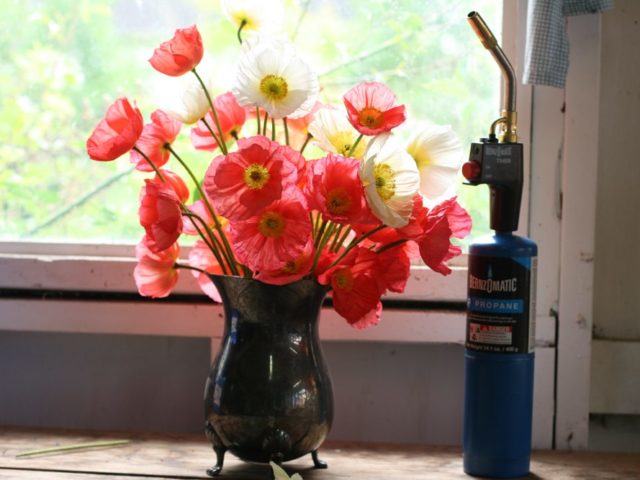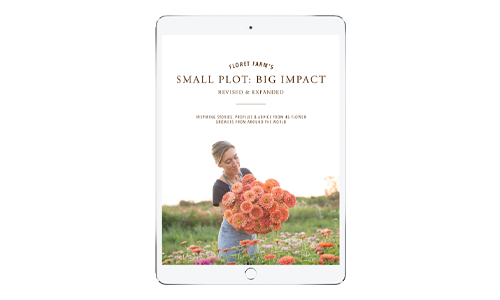The following spring, determined to have a more successful experience, I borrowed $1,000 from my mom and ordered enough landscape fabric to cover my half acre plot. While it was a huge initial investment, it was the only way I could see managing the weeds, wrangling our two small children and growing my little flower business. My husband, Chris, burned close to 15,000 holes in landscape fabric that spring, and I finally had a thriving and relatively weed-free garden.
A lot has changed since then! Both the kids and the garden have grown rapidly, but that initial batch of landscape fabric is still in use and has been added to each season. While weed suppression is our main reason for using landscape fabric, there are a few additional benefits worth noting.
First, unlike plastic, landscape fabric is reusable. The majority of our stock is in its 10th season, showing little to no wear. I also inherited a bunch from a former flower farmer that’s 25 years old and still in pretty good shape considering its age. Second, flowers like zinnias, celosia, and basil, which like heat, thrive when planted into the fabric. Third, moisture retention seems to be greatly increased with the use of fabric. Fourth, fabric makes for a tidy, clean-looking garden, which is always a bonus! Fifth, plant spacing is a snap when the holes are preset. Lastly, we generally only have to do two early rounds of weeding on the fabric beds before they can coast for the rest of the season. Compared to the typical four or five rounds of weeding needed on our open field crops, the fabric quickly pays for itself in saved labor.


Sunbelt is the brand of landscape fabric we always buy. It is shiny on both sides (avoid the type with a fuzzy bottom), is super durable, and comes in a number of different lengths and widths. I prefer to buy the 6×300-foot foot (1.8×91 m) rolls. The 6-foot (1.8 m) width allows 4 feet (1.2 m) for the growing bed, and, if overlapped with another swath of fabric, a 2-foot-wide (0.6 m) path in between beds, which allows room for planting and harvesting.
To burn the holes you need a small propane canister with a trigger switch. They can be found at most hardware stores for around $60. For perfect spacing and increased efficiency, you will need to use a template to burn the holes into the fabric. The first season I was in such a rush to get started that I made my templates out of cardboard, tin foil and duct tape. As cheesy as they were, they got the job done much better than just eyeballing the spacing. After hundreds of requests from gardeners and flower farmers all over the country, we’ve finally partnered with a local metal shop to manufacture our custom Fabric Burning Templates.


In past years we’ve burned the fabric outdoors on our driveway, but when when the wind kicks up, we’ve had to move the project inside. Our garage has a large concrete floor and plenty of big doors that can be rolled open for good ventilation, as the propane fumes are strong. With music cranked and someone to help move the template, we are able to burn a 300-foot (91 m) roll that has 1,600 holes spaced 9 inches (23 cm) apart in a little over an hour. The most common hole spacings that we use on our farm are 6-inch (15 cm), 9-inch (30 cm), 12-inch (30 cm), 18-inch (46 cm), and 8×12-inch (20×30 cm) spacing for vines.
The 6×6-inch (15 cm) spacing allows 7 rows per bed and is used on crops that have single non-branching stems like Bombay celosia or single stem sunflowers. The 9×9-inch (23 cm) spacing allows 5 rows per bed and is what we use on 80% of our annual crops. Flowers such as zinnias, basil, snapdragons, bupleurum, and honeywort all thrive in the 9×9-inch planting distance. The 12×12-inch (30 cm) spacing allows 4 rows per bed and is great for bulky growers like bells of Ireland and amaranth. The 18×18-inch (46 cm) spacing is great for large plants like branching sunflowers and eucalyptus. For vine spacing, we use 8 inches (20 cm) between plants in the row and 12 inches (30 cm) between each row. Each bed has 2 rows of vines.

Before laying the fabric, we amend the beds with compost and fertilizer, lightly till, and then lay four lines of drip irrigation per bed. You can read all about our approach to soil preparation here. We then roll the fabric out over the beds and anchor it into the soil with 6-inch (15-cm) metal pins. These earth staples can be purchased from your local landscape supply company by the case.
We then transplant seedlings into the holes with our favorite planting tool, a butter knife. Nothing does the job better! The babies are given a light overhead watering after planting and then a long drip irrigation soaking. We come through weekly in the spring to spray the plants with compost tea and then later add a layer or two of Tenax Hortonova netting to provide support for the plants so that they don’t topple over from wind or rain.




After a crop has been harvested, we remove the netting and mow the plants down with our brush hog set 2 feet above the ground. We then chain the ends of the fabric to our tractor bucket and pull it up.
While using landscape fabric is certainly more labor-intensive than straight field planting on the front and back end of the season, we’ve found that the added weed suppression, heat, perfect spacing, and labor saved during mid-season are well worth the effort.





